The Granulated Tapioca Market is estimated to be valued at USD 0.8 billion in 2025 and is projected to reach USD 1.3 billion by 2035, registering a compound annual growth rate (CAGR) of 5.2% over the forecast period.
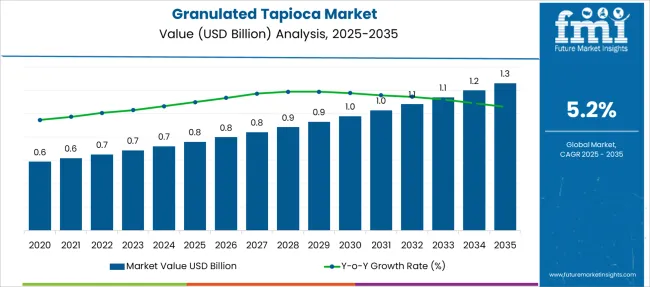
| Metric | Value |
|---|---|
| Granulated Tapioca Market Estimated Value in (2025 E) | USD 0.8 billion |
| Granulated Tapioca Market Forecast Value in (2035 F) | USD 1.3 billion |
| Forecast CAGR (2025 to 2035) | 5.2% |
The granulated tapioca market is expanding steadily as consumer demand for natural and organic food ingredients continues to rise. Health-conscious consumers are increasingly seeking organic products, which has driven growth in this segment. The versatility of granulated tapioca as an ingredient in food and beverage applications has further supported market expansion.
Advances in sustainable farming practices and certification standards have enhanced the availability and appeal of organic tapioca. Packaging innovations such as stand-up pouches have improved product convenience and shelf life, making tapioca more accessible for both industrial and retail use.
Growing trends toward clean-label products and plant-based diets are expected to boost demand further. The market is also benefiting from tapioca’s functional properties, especially as a thickening agent in processed foods and sauces. Segmental growth is anticipated to be led by the organic nature category, stand-up pouches as the preferred packaging format, and thickening agent functionality.
The market is segmented by Nature, Packaging, Function, Application, and Distribution Channel and region. By Nature, the market is divided into Organic and Synthetic. In terms of Packaging, the market is classified into Stand-up Pouches, Jars, and Tetra Pak. Based on Function, the market is segmented into Thickening Agent and Texturizer. By Application, the market is divided into Pudding, Bubble Gum, Tea, Candies and Desserts, Soups and Gravies, Pie Fillings, Sweet Soups, and Others. By Distribution Channel, the market is segmented into Direct Sales (B2B), Indirect Sales (B2C), Hypermarkets/ Supermarkets, Online Stores, Specialty Stores, and Other Retailers. Regionally, the market is classified into North America, Latin America, Western Europe, Eastern Europe, Balkan & Baltic Countries, Russia & Belarus, Central Asia, East Asia, South Asia & Pacific, and the Middle East & Africa.
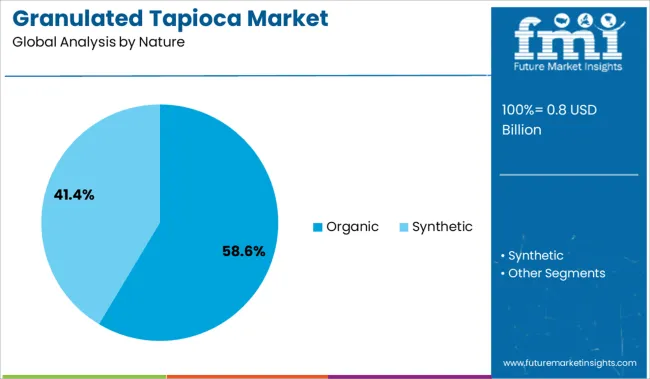
The organic segment is projected to represent 58.6% of the granulated tapioca market revenue in 2025, establishing itself as the dominant nature category. This growth is supported by the increasing preference for organic food ingredients that are free from synthetic pesticides and genetically modified organisms. Consumer awareness regarding food safety and environmental sustainability has bolstered demand for organic tapioca.
Producers have responded by adopting organic farming practices and securing certifications that assure quality and traceability. The organic segment’s appeal is heightened by its alignment with clean-label trends and the rising popularity of natural ingredients in the food industry.
As consumers prioritize health and sustainability, the organic granulated tapioca segment is expected to maintain its market leadership.
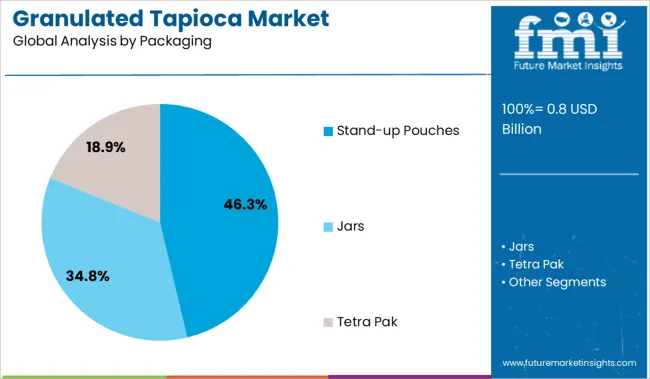
Stand-up pouches are forecasted to contribute 46.3% of the granulated tapioca market revenue in 2025, positioning them as the leading packaging format. Their growth is driven by the convenience they offer in terms of resealability, portability, and extended product freshness.
Manufacturers prefer stand-up pouches as they are lightweight and cost-effective compared to traditional packaging options. These pouches also support branding and product differentiation through customizable designs.
Retailers and consumers appreciate the ease of storage and handling that stand-up pouches provide. With increasing demand for user-friendly packaging in the food industry, this format is expected to continue dominating the market.
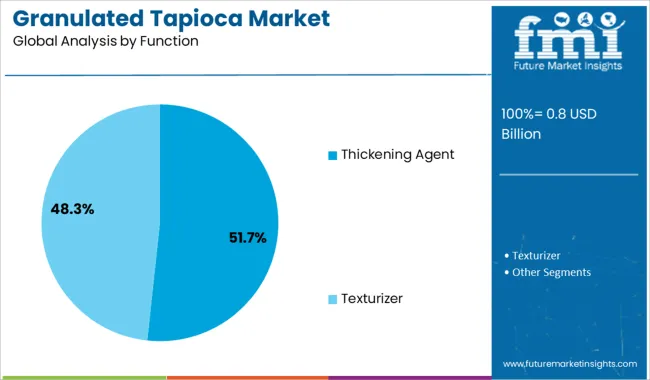
The thickening agent function segment is expected to hold 51.7% of the granulated tapioca market revenue in 2025, maintaining its leading role in application uses. Granulated tapioca is favored for its excellent thickening and stabilizing properties in a wide range of food products including soups, sauces, and desserts.
Food manufacturers prefer it due to its neutral taste, gluten-free nature, and ability to improve texture and consistency. The demand for clean-label and allergen-free thickeners has increased the use of tapioca in both industrial and consumer food formulations.
Its functional versatility combined with health benefits is driving sustained adoption in this segment.
Due to the growing adoption of sundry lifestyles and changing eating habits, there is a swift rise in prevalence of intolerance related to the consumption of gluten and condition such as non-celiac gluten sensitivity (NCGS), and celiac disease.
For instance, according to the American Academy of Allergy Asthma & Immunology, nearly 1% to 4% of the population across the world are reported to be suffering from celiac disease, an autoimmune disorder of the small intestine triggered by gluten. This rise in burden of such conditions is anticipated to augment the adoption of gluten-based product alternatives such as granulated tapioca, thereby bolstering the sales in the global market.
Also, increasing demand for high fiber compounds such as cassava extract’s across the dietary sector, owing to their effectiveness in preventing constipation, reducing the cholesterol level, and maintaining blood sugar levels is expected to further favor the sales of granulated tapioca.
Growing awareness about to the excess intake of carbohydrates and declination in consumption of pie fillings, pudding, desserts, candies, and others, owing to the rising health concerns and increasing obese population is hindering the sales of granulated tapioca.
Also, risk of cyanide poisoning, due to the presence of a toxic compound called linamarin, present in cassava roots and side effects such as diarrhea, bloating, and nausea associated with the consumption of tapioca is hampering the growth in the global market.
South Asia is estimated to emerge as a highly remunerative market for granulated tapioca from 2025 to 2035, reveals Future Market Insights.
In the past couple of years, a swift rise in the number of baby births is being witnessed across South Asia, boosting the demand for baby food and nutritional supplements. For instance, according to the United Nations International Children's Emergency Fund (UNICEF), approximately 67,385 babies are reported to be born each day in India.
Granulated tapioca is extensively used as bodying and thickening agent in a plethora of commercially produced infant nutritional supplements and baby food products. Hence, growing baby births are projected to soar the demand for granulated tapioca in the South Asia market.
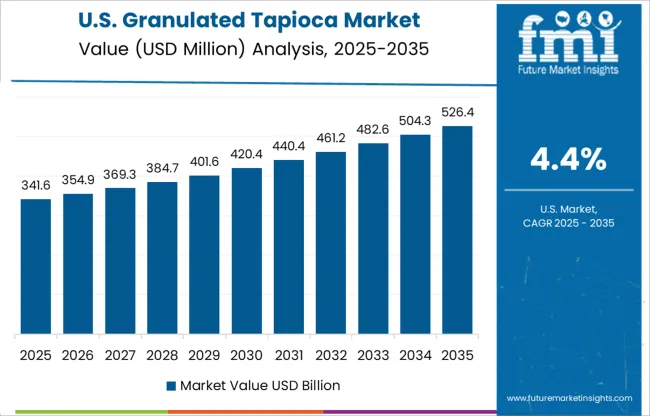
As per a study by FMI, North America is anticipated to account for a significant share in the global granulated tapioca market from 2025 to 2035.
Growing customer preference towards adopting plant-based ingredients for preparation of food & beverage products and rising consumption of thick gravies, soups, pie, pudding, and others are fueling the demand for tapioca products. Hence, key players are focusing on launching new products to cater to this demand.
For instance, in 2024, Kauffman's Fruit Farm, a USA-based producer of tapioca products announced introducing Granulated Minute Tapioca in 2-pound packaging. A slew of such product launches is expected to bolster the growth in the North America market.
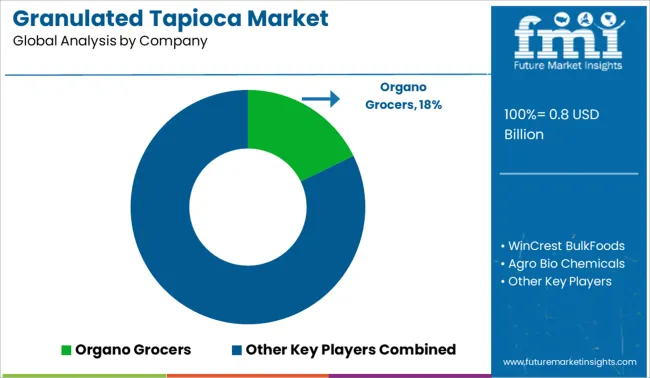
Some of the leading players in the granulated tapioca market are Edward and Sons, WinCrest BulkFoods, COMBRASIL, Amafil, YOKI, Red Hill General Stores, Inc., Larissa Veronica, Kauffman's Fruit Farm, Choice Tropical, LLC, Varies, Pa Dutch Food & Candy Company, and others.
Key manufacturers are aiming at launching new products in different size packaging and expanding their production capacity to strengthen their foothold in the highly competitive granulated tapioca market.
| Report Attribute | Details |
|---|---|
| Growth Rate | CAGR of 4% to 5% from 2025 to 2035 |
| Base Year for Estimation | 2024 |
| Historical Data | 2020 to 2024 |
| Forecast Period | 2025 to 2035 |
| Quantitative Units | Revenue in USD Million and CAGR from 2025 to 2035 |
| Report Coverage | Revenue Forecast; Volume Forecast; Company Ranking; Competitive Landscape; Growth Factors; Trends and Pricing Analysis |
| Segments Covered | Nature, Packaging, Function, Application, Distribution Channel, Region |
| Countries Covered | North America; Latin America; Europe; East Asia; South Asia; Oceania; Middle East and Africa |
| Key Companies Profiled | Edward and Sons; WinCrest BulkFoods; COMBRASIL; Amafil; YOKI; Red Hill General Stores, Inc.; Larissa Veronica; Kauffman's Fruit Farm; Choice Tropical, LLC; Varies; Pa Dutch Food & Candy Company; Others |
| Customization | Available Upon Request |
The global granulated tapioca market is estimated to be valued at USD 0.8 billion in 2025.
The market size for the granulated tapioca market is projected to reach USD 1.3 billion by 2035.
The granulated tapioca market is expected to grow at a 5.2% CAGR between 2025 and 2035.
The key product types in granulated tapioca market are organic and synthetic.
In terms of packaging, stand-up pouches segment to command 46.3% share in the granulated tapioca market in 2025.






Our Research Products

The "Full Research Suite" delivers actionable market intel, deep dives on markets or technologies, so clients act faster, cut risk, and unlock growth.

The Leaderboard benchmarks and ranks top vendors, classifying them as Established Leaders, Leading Challengers, or Disruptors & Challengers.

Locates where complements amplify value and substitutes erode it, forecasting net impact by horizon

We deliver granular, decision-grade intel: market sizing, 5-year forecasts, pricing, adoption, usage, revenue, and operational KPIs—plus competitor tracking, regulation, and value chains—across 60 countries broadly.

Spot the shifts before they hit your P&L. We track inflection points, adoption curves, pricing moves, and ecosystem plays to show where demand is heading, why it is changing, and what to do next across high-growth markets and disruptive tech

Real-time reads of user behavior. We track shifting priorities, perceptions of today’s and next-gen services, and provider experience, then pace how fast tech moves from trial to adoption, blending buyer, consumer, and channel inputs with social signals (#WhySwitch, #UX).

Partner with our analyst team to build a custom report designed around your business priorities. From analysing market trends to assessing competitors or crafting bespoke datasets, we tailor insights to your needs.
Supplier Intelligence
Discovery & Profiling
Capacity & Footprint
Performance & Risk
Compliance & Governance
Commercial Readiness
Who Supplies Whom
Scorecards & Shortlists
Playbooks & Docs
Category Intelligence
Definition & Scope
Demand & Use Cases
Cost Drivers
Market Structure
Supply Chain Map
Trade & Policy
Operating Norms
Deliverables
Buyer Intelligence
Account Basics
Spend & Scope
Procurement Model
Vendor Requirements
Terms & Policies
Entry Strategy
Pain Points & Triggers
Outputs
Pricing Analysis
Benchmarks
Trends
Should-Cost
Indexation
Landed Cost
Commercial Terms
Deliverables
Brand Analysis
Positioning & Value Prop
Share & Presence
Customer Evidence
Go-to-Market
Digital & Reputation
Compliance & Trust
KPIs & Gaps
Outputs
Full Research Suite comprises of:
Market outlook & trends analysis
Interviews & case studies
Strategic recommendations
Vendor profiles & capabilities analysis
5-year forecasts
8 regions and 60+ country-level data splits
Market segment data splits
12 months of continuous data updates
DELIVERED AS:
PDF EXCEL ONLINE
Granulated Sugar Market
Tapioca Pearls Market Analysis - Size, Share, and Forecast 2025 to 2035
Tapioca Maltodextrin Market Analysis - Size, Share, and Forecast Outlook 2025 to 2035
Tapioca Market Trends - Starch Solutions & Global Demand 2025 to 2035

Thank you!
You will receive an email from our Business Development Manager. Please be sure to check your SPAM/JUNK folder too.
Chat With
MaRIA